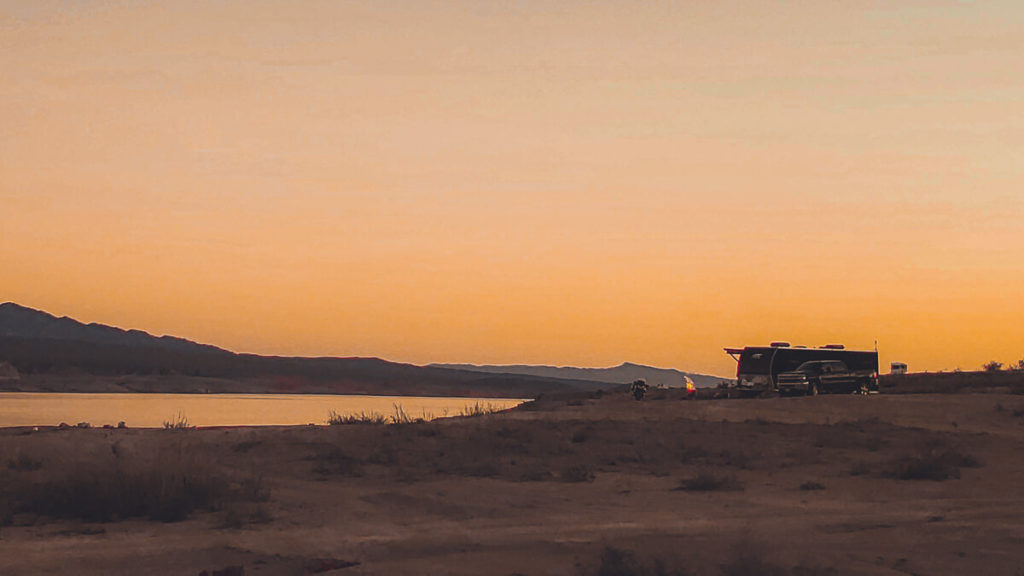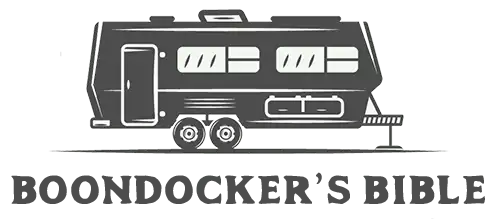Yes, you can have a campfire while boondocking on BLM and US Forest Service lands. Other federal land management agencies including National Park Service, Army Corps of Engineers, Bureau of Reclamation, and US Fish & Wildlife Service, will allow campfires only in areas designated for campfires, and usually only contained in established fire rings and grills. Campfires are subject to fire restrictions based on current weather conditions.

Can You Have a Campfire While Boondocking?
Note that this article is specific to boondocking. For more general discussion on having campfires on federally managed lands, see “Is it Illegal to Start a Campfire?“
Bureau of Land Management
Yes, campfires are allowed on most BLM lands.
The BLM is the most lenient when it comes to campfires. In general, they have no laws or rules mentioning campfires at all, which means there is nothing to stop you from building one. Moreover, they have no requirements on using a container of any kind, meaning you can assemble a ring of rocks or just pile up a bunch of wood on the ground. But this only applies to “public lands” which are lands that have no special protections. About 80 to 90% of BLM land is “public land”.
Each BLM state office and field office is allowed to implement fire restrictions at any time depending on weather and other conditions. The only way to know if a restriction is in place is to visit the BLM website, drill down to a specific state, and read their latest press releases.
The BLM also allow campfires on “conservation lands”, which include national monuments, and other protected areas. Each national monument is allowed to set its own rules. For the most part, they all seem to allow campfires as a general rule; it’s just best to check with a visitor center to find out what special restrictions they may have.
- The BLM also respects state fire and forestry agencies, and will allow their laws and rules to take precedence over BLM lands.
U.S. Forest Service
Yes, campfires are allowed on most U.S. Forest Service lands.
The U.S. Forest Service manages all the country’s national forests and national grasslands. They don’t have any laws or regulations on a nationwide scale prohibiting campfires, nor do they have anything restricting what kind of container to use. They do, however, have regulations in place prohibiting negligence and carelessness. You can read these regulations at, “Title 36 § 261.5 Fire“
However, the U.S. Forest Service empowers each specific national forest and national grassland to implement its own restrictions, and each one does do so from a highly-managed standpoint. Most forests and grasslands still allow you to have a campfire, but will often implement restrictions in certain areas or at certain times of the year. Some forests and grasslands will ban all campfires in all areas on an indefinite basis.
The only way to know if a fire restriction is in place is to contact main office of a national forest or grassland, or visit the U.S. Forest Service website and drill down to a specific forest.
National Park Service
No, the National Park Service generally does not allow campfires while boondocking (or backcountry camping), unless it’s confined to a fire ring or cooking grill provided by the NPS.
The NPS operates more than just national parks; they also operate “national recreation areas”, “national monuments”, “national seashores”, among others. Most NPS properties will allow boondocking (or backcountry camping), but is restricted to hikers and tent campers. Even in these cases, campfires are still restricted to designated backcountry camping areas, and in fire rings or cooking grills provided by the NPS.
Otherwise, no NPS property allows you to assemble a campfire anywhere you want. Almost always, any fire is restricted to designated areas, and confined to some kind of container designed for campfire or cooking.
The National Park Service does have a set of regulations with respect to campfires which you can read at, “Title 36, § 2.13 Fires”. However, each national park, national recreation area, national monument, national seashore, etc., will establish its own specific policies.
Army Corps of Engineers
No, the Army Corps of Engineers generally does not allow for boondocking. They do however, have many designated primitive camping areas where you are allowed to camp anywhere you want within that area. Campfires are usually permitted in those areas.
Otherwise, you are never allowed to start a fire outside of a developed campground or designated primitive camping area.
All campfires are restricted to a container designed for campfires or cooking, either one provided by the ACOE or something you bring in yourself. You are never allowed to assemble a ring of rocks, or pile together a bunch of wood, and have a bonfire on the ground.
Each ACOE campground or primitive camping area falls within a specific district. Each district is free to enact its own policies with respect to camping and campfires. These policies are always posted on an information board located in each campground and primitive camping area.
The ACOE has adopted some basic regulations with respect to fires which you can read at, “Title 36, § 327.10 Fires“.
Bureau of Reclamation
Yes, campfires are allowed on Bureau of Reclamation lands.
However, the Bureau of Reclamation has very basic and broad rules with respect to camping and campfires. This is particularly because each Bureau-owned reservoir prefers to set its own policies on recreation. In many instances, the Bureau will outsource a reservoir’s recreation program to another agency, usually the National Park Service, or a state agency, or even a county agency. In that case, it defers all camping policies to that agency.
What it all amounts to is that each reservoir is different, and will have its own camping policies posted on an information sign somewhere, or on a brochure handed to you at the gate.
In the unlikely event a reservoir has no policies on campfires and no policies on where to camp, then the national rules apply, which is that you can camp anywhere and have any kind of campfire you want.
Read the Bureau’s national rules on camping, “Title 43, § 423.33 Camping“, and their rules on campfires, “Title 43, § 423.31 Fires and flammable material“.
U.S. Fish & Wildlife Service
No, generally campfires are not allowed when boondocking.
First of all, of the handful of national wildlife refuges that allow for camping, almost all prohibit boondocking. They instead restrict camping to developed campgrounds or designated primitive camping areas. They do allow campfires in these areas, but are restricted to fire rings and cooking grills provided by the refuge, or within a container or cooking grill that you bring with you.
The only national wildlife refuges that we know of that allow boondocking all across their lands, and permits campfires wherever you camp, is Kofa National Wildlife Refuge, and Cabeza Prieta National Wildlife Refuge, both in Arizona.
The U.S. Fish & Wildlife Service does have a small set of national regulations with respect to fires which you can read at, “Title 50, § 27.95 Fires”.

